In ‘Scott Pilgrim vs. the World’, unique camera and framing tricks are used to highlight drama in the story, allowing for emotions the characters are feeling to be expressed without words in a very quick and effective manner. In this scene, many of the shots are medium close-up (MCU) of a certain character, but often include other characters in dynamic ways.
https://youtu.be/R-aJ-2y5ICo?si=yxFdUZORi_018pxq
In this scene, we see Scott at a his band’s show, which he has invited Ramona Flowers (his crush) to. As she arrives, she meets his band and friends, including his current girlfriend, Knives. As Scott deals with his mistake, the viewer sees the tense game of emotions being tossed from person to person.
In the first shot, we see Ramona at close-up (CU) between Scott and Knives, who have just kissed and are at extreme close-up (ECU). This begins the loop of tension moving throughout the characters.

The screen then shifts to CU of Scott, who looks from left to right in one shot. Even though the viewer can’t see what he’s looking at, the preceding and following shots, as well as the emotion, help tell the audience who he looks to and from (Ramona to Knives).

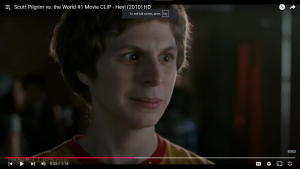
As Scott looks at Knives, the shot changes to a CU of her. Included is a MCU of Wallace (Scott’s roommate), which helps establish where everyone is within the shot.
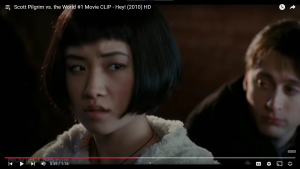
The shot then zooms out, becoming a MCU of Knives and a CU of Ramona, showing Knives’ tension towards her.
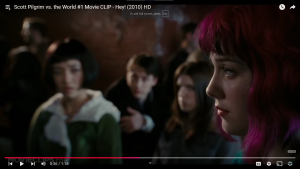
It then switches to a CU of Scott’s sister, showing an CU/ECU of Knives in front of her, looking the same direction.
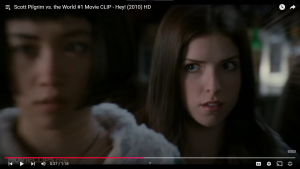
When the shot zooms out, we see that they are both looking at Scott, who is now CU. This exemplifies their anger at him.

Then the shot changes to a CU of Wallace-
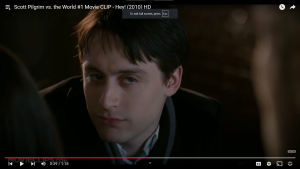
–who is looking towards Scott’s sister’s boyfriend, setting up tension on the side as well, as Wallace is attracted to him. The boyfriend looks away uncomfortably.
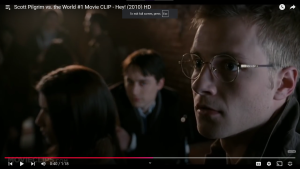
It then switches to the final CU of Scott, the instigator of the entire problem.

The audience then sees a medium shot (M) of everyone looking at Scott, showing the bulk of people who are upset with him after focusing on each of them one by one. This passes the tension from character to character, shot to shot, quite smoothly.

Finally, the camera then shows the final CU of Scott again, before he runs away from his problems, as is common for the character. The camera stays in place as he escapes, showing the ECU back angles of Ramona and Knives as Scott goes from CU to long shot (LS).

Overall, this playful and dynamic use of framing and zooming out allows the viewer to digest a large amount of information rather quickly and easily. It keeps the viewer more engaged than if each character explained who they were upset with and why. Additionally, the repetitive nature of the shots zooming out adds to the tension of the narrative, as the viewer isn’t sure who is going to be seen next or how deep each character’s emotions actually run.